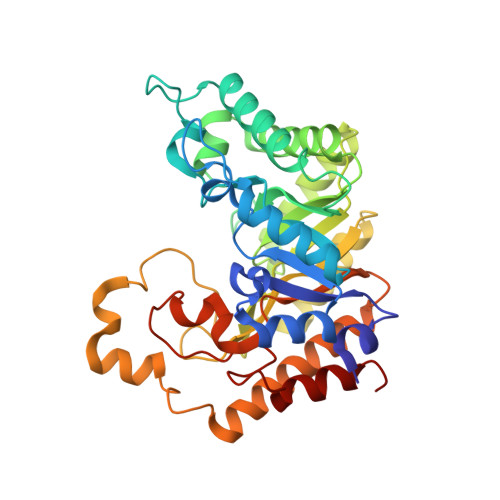Molecular mechanisms associated with xylan degradation by xanthomonas plant pathogens.
Santos, C.R., Hoffmam, Z.B., de Matos Martins, V.P., Zanphorlin, L.M., de Paula Assis, L.H., Honorato, R.V., Lopes de Oliveira, P.S., Ruller, R., Murakami, M.T.(2014) J Biol Chem 289: 32186-32200
- PubMed: 25266726
- DOI: https://doi.org/10.1074/jbc.M114.605105
- Primary Citation of Related Structures:
4PMU, 4PMV, 4PMX - PubMed Abstract:
Xanthomonas pathogens attack a variety of economically relevant plants, and their xylan CUT system (carbohydrate utilization with TonB-dependent outer membrane transporter system) contains two major xylanase-related genes, xynA and xynB, which influence biofilm formation and virulence by molecular mechanisms that are still elusive. Herein, we demonstrated that XynA is a rare reducing end xylose-releasing exo-oligoxylanase and not an endo-β-1,4-xylanase as predicted. Structural analysis revealed that an insertion in the β7-α7 loop induces dimerization and promotes a physical barrier at the +2 subsite conferring this unique mode of action within the GH10 family. A single mutation that impaired dimerization became XynA active against xylan, and high endolytic activity was achieved when this loop was tailored to match a canonical sequence of endo-β-1,4-xylanases, supporting our mechanistic model. On the other hand, the divergent XynB proved to be a classical endo-β-1,4-xylanase, despite the low sequence similarity to characterized GH10 xylanases. Interestingly, this enzyme contains a calcium ion bound nearby to the glycone-binding region, which is required for catalytic activity and structural stability. These results shed light on the molecular basis for xylan degradation by Xanthomonas and suggest how these enzymes synergistically assist infection and pathogenesis. Our findings indicate that XynB contributes to breach the plant cell wall barrier, providing nutrients and facilitating the translocation of effector molecules, whereas the exo-oligoxylanase XynA possibly participates in the suppression of oligosaccharide-induced immune responses.
Organizational Affiliation:
Biosciences National Laboratory and National Center for Research in Energy and Materials, Campinas, São Paulo, 13083-970, Brazil.














